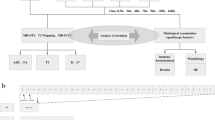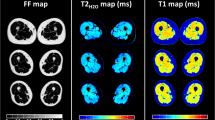Abstract
To investigate the time-course of changes in transverse relaxation time (T2) and cross-sectional area (CSA) of the quadriceps muscle after a single session of eccentric exercise, magnetic resonance imaging was performed on six healthy male volunteers before and at 0, 7, 15, 20, 30 and 60 min and 12, 24, 36, 48, 72 and 168 h after exercise. Although there was almost no muscle soreness immediately after exercise, it started to increase 1 day after, peaking 1–2 days after the exercise (P<0.01). Immediately after exercise, T2 increased significantly in the rectus femoris, vastus lateralis and intermedius muscles (P<0.05) and decreased quickly continuing until 60 min after exercise. At and after the 12th h, a significant increase was perceived again in the T2 values of the vastus lateralis and intermedius muscles (P<0.01) [maximum 9.3 (SEM 2.8)% and 10.9 (SEM 2.2)%, respectively]. The maximal values were exhibited at 24–36 h after exercise. In contrast, the rectus femoris muscle showed no delayed-stage increase. Also, in CSA, an increase after 12 h was observed in addition to the one immediately after exercise in the vastus lateralis, intermedius and medialis and quadriceps muscles as a whole (P < 0.01), reaching the maximal values at 12–24 h after exercise. The plasma creative kinase activity remained unchanged up to 24 h after and then increased significantly 48 h after exercise (P < 0.05). Beginning 12 h after exercise, the subjects whose T2 and CSA increased less than the others displayed a faster decrease in muscle soreness. These results suggested that T2 and CSA displayed bimodal responses after eccentric exercise and the time-courses of changes in them were similar to those in muscle soreness.
Similar content being viewed by others
References
Archer BT, Fleckenstein JL, Bertocci LA, Haller RG, Barker B, Parkey RW, Peshock RM (1992) Effect of perfusion on exercised muscle: MR imaging evaluation. J Magn Reson Imaging 2:407–413
Armstrong RB, Ogilvie RW, Schwane JA (1983) Eccentric exercise-induced injury to rat skeletal muscle. J Appl Physiol 54:80–93
Barcroft H, Dornhorst AC (1949) The blood flow through the human calf during rhythmic exercise. J Physiol 109:402–411
Brendstrup P (1962) Late edema after muscular exercise. Arch Phys Med Rehabil 43:401–405
Clarkson PM, Tremblay I (1988) Exercise-induced muscle damage, repair, and adaptation in humans. J Appl Physiol 65:1–6
Edgerton VR, Smith JL, Simpson DR (1975) Muscle fibre type populations of human leg muscles. Histochem J 7:259–266
Elsner RW, Carlson LD (1962) Postexercise hyperemia in trained and untrained subjects. J Appl Physiol 17:436–440
Fisher MJ, Meyer RA, Adams GR, Foley JM, Potchen EJ (1990) Direct relationship between proton T2 and exercise intensity in skeletal muscle MR images. Invest Radiol 25:480–485
Fleckenstein JL, Canby RC, Parkey RW, Peshock RM (1988) Acute effects of exercise on MR imaging of skeletal muscle in normal volunteers. Am J Roentgenol 151:231–237
Fleckenstein JL, Weatherall PT, Parkey RW, Payne JA, Peshock RM (1989) Sports-related muscle injuries: evaluation with MR imaging. Radiology 172:793–798
Fotedar LK, Slopis JM, Narayama PA, Fenstermacher MJ, Pivarnik J, Butler IJ (1990) Proton magnetic resonance of exerciseinduced water changes in gastrocnemius muscle. J Appl Physiol 69:1695–1701
Fridén J (1984) Muscle soreness after exercise: implications of morphological changes. Int J Sports Med 5:57–66
Fridén J, Sjostrom M, Ekblom B (1981) A morphological study of delayed muscle soreness. Experientia 37:506–507
Fridén J, Sjostrom M, Ekblom B (1983) Myofibrillar damage following intense eccentric exercise in man. Int J Sports Med 4:170–176
Fridén J, Sfakianos PN, Hargens AR, Akeson WH (1988) Residual muscular swelling after repetitive eccentric contractions. J Orthop Res 6:493–498
Hall AS, Prior MV, Hand JW, Young IR, Dickinson RJ (1990) Observation by MR imaging of in vivo temperature changes induced by radio frequency hyperthermia. J Comput Assist Tomogr 14:430–436
Johnson MA, Polgar J, Weightman D, Appleton D (1973) Data on the distribution of fibre types in thirty-six human muscles: an autopsy study. J Neurol Sci 18:111–129
Jones DA, Newham DJ, Round JM, Tolfree SE (1986) Experimental human muscle damage: morphological changes in relation to other indices of damage. J Physiol 375:435–448
Le Rumeur E, Certaines J de, Toulouse P, Rochcongar P (1987) Water phases in rat striated muscles as determined by T2 proton NMR relaxation times. Magn Reson Imaging 5:267–272
Lind AR, McNicol GW (1967) Local and central circulatory responses to sustained contractions and the effect of free or restricted arterial inflow on post-exercise hyperemia. J Physiol 192:575–593
Mair J, Koller A, Artner DE, Haid C, Wicke K, Judmaier W, Puschendorf B (1992) Effects of exercise on plasma myosin heavy chain fragments and MRI of skeletal muscle. J Appl Physiol 72:656–663
McCully K, Shellock FG, Bank WJ, Posner JD (1992) The use of nuclear magnetic resonance to evaluate muscle injury. Med Sci Sports Exerc 24:537–542
Nadel ER, Bergh ULF, Saltin B (1972) Body temperatures during negative work exercise. J Appl Physiol 33:553–558
Nelson TR, Tung SM (1987) Temperature dependence of proton relaxation times in vitro. Magn Reson Imaging 5:189–199
Newham DJ, Jones DA, Edwards RH (1983a) Large delayed plasma creatine kinase changes after stepping exercise. Muscle Nerve 6:380–385
Newham DJ, McPhail G, Mills KR, Edwards RH (1983b) Ultrastructural changes after concentric and eccentric contractions of human muscle. J Neurol Sci 61:109–122
Newham DJ, Jones DA, Clarkson PM (1987) Repeated highforce eccentric exercise: effects on muscle pain and damage. J Appl Physiol 63:1381–1386
Nosaka K, Clarkson PM, Apple FS (1992) Time course of serum protein changes after strenuous exercise of the forearm flexors. J Lab Clin Med 119:183–188
Nurenberg P, Giddings CJ, Stray-Gundersen J, Fleckenstein JL, Gonyea WJ, Peshock RM (1992) MR imaging-guided muscle biopsy for correlation of increased signal intensity with ultrastructural change and delayed-onset muscle soreness after exercise. Radiology 184:865–869
Richardson D, Shewchuk R (1980) Effects of contraction force and frequency on postexercise hyperemia in human calf muscles. J Appl Physiol 49:649–654
Schwane JA, Johnson SR, Vandenakker CB, Armstrong RB (1983) Delayed-onset muscular soreness and plasma CPK and LDH activities after downhill running. Med Sci Sports Exerc 15:51–56
Talag TS (1973) Residual muscular soreness as influenced by concentric, eccentric, and static contractions. Res Q 44:458–469
Vihko V, Rantamäki J, Salminen A (1978) Exhaustive physical exercise and acid hydrolase activity in mouse skeletal muscle. Histochemistry 57:237–249
Yoshioka H, Niitsu M, Anno I, Takahashi H, Kuno S, Matsumoto K, Itai Y (1992) Evaluation of skeletal muscle during exercise on short repetition time MR imaging (abstract in English). Jpn J Magn Reson Med 12:276–281
Author information
Authors and Affiliations
Rights and permissions
About this article
Cite this article
Takahashi, H., Kuno, Sy., Miyamoto, T. et al. Changes in magnetic resonance images in human skeletal muscle after eccentric exercise. Europ. J. Appl. Physiol. 69, 408–413 (1994). https://doi.org/10.1007/BF00865404
Accepted:
Issue Date:
DOI: https://doi.org/10.1007/BF00865404




